Where to go from here?

Arrows
While still strong, sustainability's influence in packaging is facing continued cost pressures, global contests and a shift in who is leading the charge—all of which could impact the direction of programs moving forward.
Analysis of data from Packaging Digest's exclusive 2012 Sustainable Packaging Study shows not only the state of the current market but also hints of where it might be headed in North America in the near future.
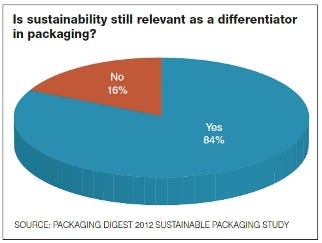
Sustainability still relevant
Cost is a four-letter wordFinancial concerns dominate this year, as they did last year. Although a hefty 84 percent of respondents say sustainability is still relevant as a differentiator in packaging, the main reason participants give for why it's not relevant for them is monetary. One respondent claims, "The sustainability trend has peaked as a [motivating] force in the packaging industry. Economics trumps all." Another one bluntly states, "[Sustainability] has become just a bogus claim in general. Long term, economics will dictate what packaging is used."
When asked which business factors will have the greatest impact on the strategic direction of their company, participants cite economic-related reasons in three of the top five factors (these were the same top five factors in 2011 but in a slightly different order):
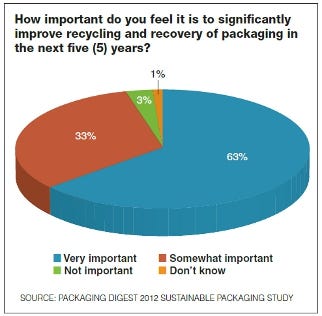
Recycling recovery importance
• Managing costs, 35 percent• Pricing pressures, 28 percent
• Consumer/market requirements, 26 percent
• Sustainability, 24 percent
• Operational efficiency, 22 percent
Notice that "sustainability" holds the No. 4 position of important business factors, underscoring corporate America's commitment to social responsibility.
When it comes to the factors that have the most influence on a company's sustainability activities in the packaging industry specifically, costs show up again. Nearly half (47 percent) of respondents put "Consumer/market demands" at the top, followed closely by "Pricing pressures" at 44 percent. In fact, 48 percent say the cost of raw materials is the biggest challenge to making their current packaging process more sustainable. Also, 65 percent "strongly" or "somewhat" agree with the statement that sustainability efforts are difficult to advance during an economic downturn.
When it comes to protecting profits, the outlook for sustainability in packaging is not entirely negative. Being "green" can help companies stay in the black, say respondents. A whopping 93 percent "strongly" or "somewhat" agree with the statement that being more efficient and saving costs is an important part of any sustainability effort.
However, expect cost concerns to be sustained throughout the near term. "Economic forces, inflation and weak dollar will have more impact in the next five years," predicts one survey taker.
Recycling still reigns
Partly because most consumers equate being "green" with recycling, many respondents plan to focus more in this area in the future—even though their efforts here dipped a bit in 2012. The percentage of people taking the survey who say "collecting for recycling" and "use of recycled materials" are areas where the company is currently implementing sustainable practices dropped, respectively, from 60 percent in 2011 to 55 percent in 2012 and from 56 percent in 2011 to 55 percent in 2012.
However, we anticipate recycling and use of recycled content will continue growing in the future. When asked, "What criteria does your company use to evaluate sustainable packaging?," recycled content made it to the top of the list, with 49 percent of respondents choosing it. Further, 95 percent of survey participants say it is "very important" or "somewhat important" to significantly improve recycling and recovery of packaging in the next five years.
Global realities, inequities
Globalization registered the sharpest increase from 2011 to 2012 on the list of business factors that will have the greatest impact on the strategic direction of survey respondent's companies in the next five years.
Therefore, it's no surprise nearly 450 of the 679 total respondents took the time to share their position when asked this open-ended question: Some countries outside of the U.S. have established tighter regulations and more specific definitions for sustainability. How are these factors affecting your company's competitive position in global markets?
The answers ranged from "not affecting us at all" to "costing us more" and "we're already leading in this area." A fair number (about two dozen) say they don't know.
Based on their replies, it's clear that many respondents realize that meeting the requirements is just a matter of doing business in that area—or not, as in the case of this participant: "These regulatory burdens reduce our interest in these markets."
The reality is, sustainability is ingrained in business practices overseas. According to one respondent, it is "definitely a factor outside the U.S.; they push sustainable packaging alternatives as part of the bidding process."
If you can meet the highest global standard, you can compete anywhere, as this participant points out: "We have to ensure our products meet European standards, even though they are sold in the U.S. We believe future U.S. regulations will be based on European standards."
One respondent sees the alternative of looser laws as just as much of an issue: "Are you also going to ask about influence of places with little or no regulation (China, India)?"
Another survey participant thought of that, too, and expresses an "If you can't beat 'em, join 'em" attitude: "Cost is high and we can't compete against product made by companies that are under no regulation to such responsibilities. We are simply priced out. Only way is to move our production into those countries to compete globally."
Is our premise that regulations are tighter outside the U.S. grounded entirely in fact? One participant begs to differ: "We have not been impacted by any governments' regulations, outside of California. However, I would be interested in seeing who has tighter regulations than California and those more specific definitions."
Several responses divulge how the conditions in other countries often dictate different material selection or sourcing. "We are definitely feeling the pressure and already have prohibited using PVC in most areas," says one respondent. And another: "We have changed some materials, usually plastics, based on regulations in other countries."
Here's an optimist who sees the challenges as opportunities: "I work in a company that sells all over the world so we must take under consideration the regulation in each country. This fact actually drives our company to know more about the issue and to think of ways to improve sustainable packaging."
Is taking the high road realistic in today's economic uncertainties? "Europe's all for ‘green'—and they're all broke. We don't do enough real international business (mostly Canada, is all) to make much of a difference, but it doesn't seem like that's the best model for success," comments one participant.
Going it alone?
Who is leading the charge these days when it comes to sustainable packaging? Individual champions now have taken the torch. On the rise since last year, the numbers of these ombudsmen have finally bypassed corporate-level leaders previously tapped to direct company initiatives. When asked who drives participation in sustainable products at your company, 42 percent say "Individual champions" in 2012 vs 31 percent in 2011.
Groups also saw bumps in 2012. "Departments" jumped from 26 percent in 2011 to 32 percent this year and "Inter-department task force" moved from 15 to 19 percent, year over year.
What dropped significantly in one year is C-level participation, dipping from 32 percent in 2011 to 25 percent in 2012. However, it's common for company executives to set a strategy, communicate its benefits to the team and turn it over to them for implementation.
What is somewhat surprising is, with so many organizations available to help, the vast majority (74 percent) of respondents say they (or their company) are not a member of any organization dedicated to improving practices in sustainable packaging, such as the Sustainable Packaging Coalition (SPC) and AMERIPEN. Perhaps these and other organizations need a more aggressive outreach program.
These are just some of the many insights to be gleaned from our study. More details will be presented at our webcast in December 2012 (see "Triple play" on p.26), including information on how to buy the study results.
Select verbatim comments from survey participants:
"We currently have 7 billion people on the planet. The population has doubled just in my lifetime of 50 years. Some estimates are that it may double again in 50 more years to 14 billion. Clearly, sustainability is the single most important issue facing our world today."
"A company that uses sustainable/less packaging materials strikes me as a company that is thinking ahead, preparing for the future."
"Bottom line, people will often show more loyalty (repeat purchase) to products/companies exhibiting responsible practices in packaging."
"Consumers generally like to feel they are contributing to environmental stewardship, as long as there is no significant cost premium."
"Given a choice between otherwise equal competitors, consumers and customers will choose the sustainable packaging user—if they know which one it is."
"In terms of regulations, costs and sourcing methods, packaging competitors need to consider sustainability as an imperative priority in a global harmonization environment."
"People are aware and offended by wasteful packaging. There is an assumed connection [between] costs and excess packaging."
METHODOLOGY
Packaging Digest's 2012 Sustainable Packaging Study was conducted via an online survey in summer 2012. Invitations to participate in the survey were e-mailed to a random sample of packaging industry decision-makers selected from Packaging Digest's subscriber database.
Findings are based on information from 679 qualified returns from Consumer Packaged Goods companies (33 percent), Packaging Material Manufacturers (16 percent), Packaging Services (16 percent), Packaging Converters (11 percent), Retailers/Wholesalers (10 percent), Packaging Machinery Manufacturers (7 percent), Transport/Logistics (6 percent), Industrial Manufacturing/B2B (4 percent) and Other / None (10 percent).
TRIPLE PLAY
Have you picked all the low-hanging fruit when it comes to implementing your company's sustainable packaging initiatives and are wondering what to do now?
Packaging advocates and sustainability experts Gail Tavill and Nina Goodrich will share their views on what's next for sustainable packaging at a free Packaging Digest webcast on Dec. 6 at 2:00 p.m. ET.
Tavill, vp, sustainable development at ConAgra Foods, will talk about recent sustainable wins at the company, as well as current efforts at the American Institute for Packaging and the Environment (AMERIPEN), of which she serves as president.
Goodrich, newly named Sustainable Packaging Coalition director at GreenBlue, will help you put your design and process strategies in context with a holistic view of sustainability, as well as will outline how to engage everyone in the supply chain, especially the consumer.
At the webcast, Packaging Digest will also present these and other key results from our exclusive 2012 Sustainable Packaging survey.
You can sign up for the free webcast—which is sponsored by BWAY Corp., DSM Engineering, TricorBraun and xpedx—by clicking the "Webcasts" tab on our homepage at www.packagingdigest.com. Hope to see you there!
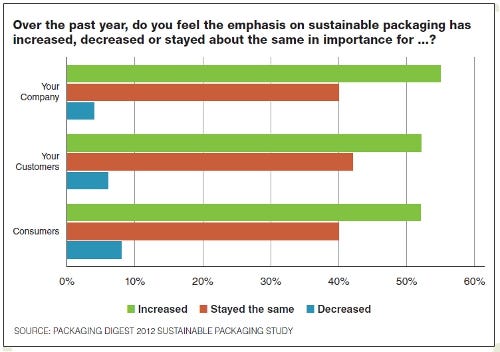
Emphasis on sustainability
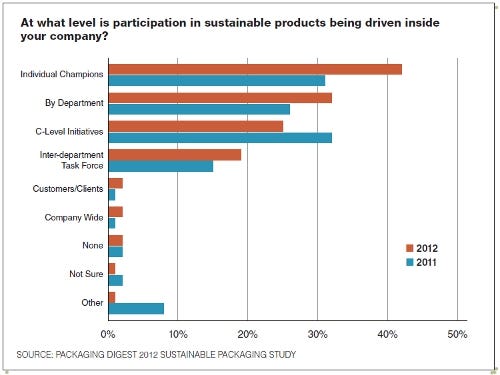
Level of participation
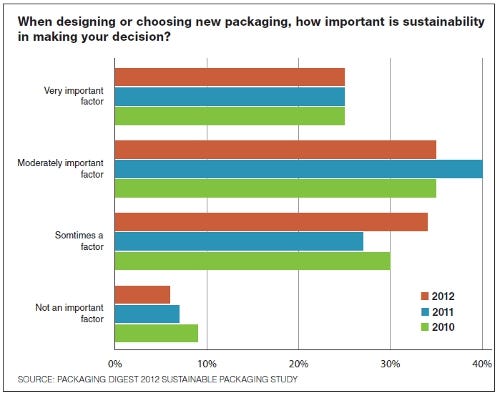
Importance in design
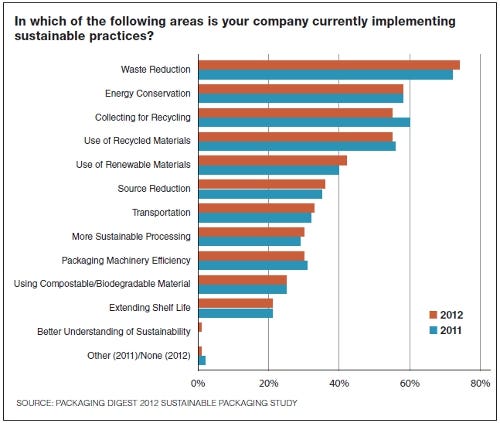
Areas of sustainability
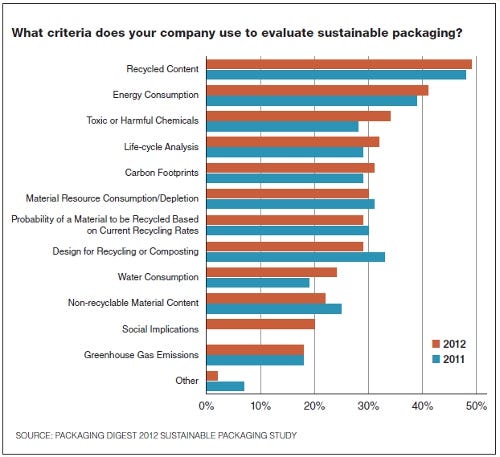
Sustainable packaging criteria
.
About the Author(s)
You May Also Like




